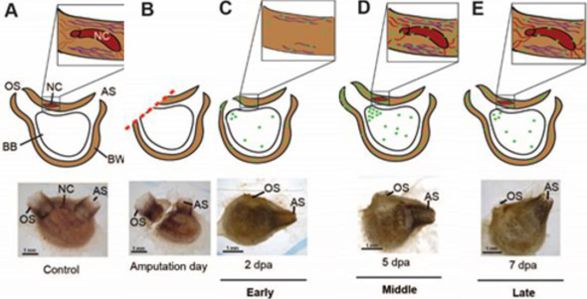
New Publication!
24.01.2023 15:25
Adult mammals have a very limited ability to regenerate neurons or part of the brain after damage therefore it is very surprising finding that species belonging to the vertebrate closest relatives, the marine invertebrate tunicates, have the capability to survive and regenerate the whole central nervous system when it is experimentally ablated. This is the case of the solitary ascidian Polycarpa mitiligera, a tunicate of the Red Sea, which succeeds in rebuilding its brain (an ovoid cerebral ganglion) in seven days.
The paper “Stemness activity underlying whole brain regeneration in a basal chordate” published in the journal cells (https://www.mdpi.com/2073-4409/11/23/3727) shows by means of transcriptome sequencing, cellular labeling, and proliferation in vivo essays that brain regeneration is mediated by a newly formed neural progeny and the activation of neurodevelopmental pathways associated with enhanced stem-cell activity. The research has been coordinated by Tal Gordon (Tel Aviv University), Lucia Manni (together with Federico Caicci, DiBio, University of Padua), Noa Shenkar (Tel Aviv University), Ayelet Voskoboynik (Stanford University). It describes the anatomical and functional stages of brain regeneration, finding a higher regenerative ability in juveniles with respect to adult individuals. Thanks to experiments evaluating cell proliferation, undifferentiated progenitor cells were found to participate to brain regeneration. Moreover, analyzing the expression of 239 activated pathways, the research enabled a quantitative understanding of gene-set enrichment patterns at key regeneration stages. The early regeneration stage was characterized by activation of cell proliferation and chromatin organization pathways, and several stem-cell related pathways, including transcriptional regulators such as sox2, hes1, and c-myb. The mid regeneration stage displayed an enrichment in pathways associated to inflammation control and wound response. The late stage de novo regenerated brain revealed upregulation of genes related to extracellular matrix secretion and axis specification, implying a continuous process of tissue assembly and specialization.
As recruiting endogenous and exogenous neural stem cells for central nervous system regeneration has become one of the main goals of regenerative medicine, the identification of neural stem cell conserved activating genes in this simple model system offers a promising approach for enhancing neurogenesis and developing therapeutic applications in vivo.
Reference: Tal Gordon, Tal Zaquin, Mark Alec Kowarsky, Yotam Voskoboynik, Noam Hendin, Omri Wurtzel, Federico Caicci, Lucia Manni, Ayelet Voskoboynik, Noa Shenkar. 2022. Stemness activity underlying whole brain regeneration in a basal chordate. Cells 11:3727. doi.org/10.3390/cells11233727
- Files:





